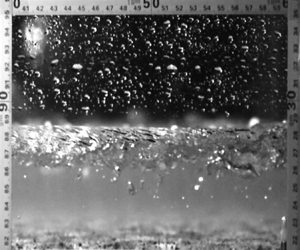Article contents
Turbulent free-surface in self-aerated flows: superposition of entrapped and entrained air
Published online by Cambridge University Press: 01 February 2024
Abstract

The characterisation and the modelling of air concentration distributions in self-aerated free-surface flows has been subject to sustained research interest since the 1970s. Recently, a novel two-state formulation of the structure of a self-aerated flow was proposed by Kramer & Valero (J. Fluid Mech., vol. 966, 2023, A37), which physically explains the air concentration through the weak interaction of two canonical flow momentum layers, comprising a turbulent boundary layer and a turbulent wavy layer (TWL). The TWL was modelled using a Gaussian error function, assuming that the most dominant contribution are wave troughs. Here, it is shown that air bubbles form an integral part of the TWL, and its formulation is expanded by adopting a superposition principle of entrapped air (waves) and entrained air (bubbles). Combining the superposition principle with the two-state formulation, an expression for the depth-averaged (mean) air concentration is derived, which allows us to quantify the contribution of different physical mechanisms to the mean air concentration. Overall, the presented concepts help to uncover new flow physics, thereby contributing fundamentally to our understanding of self-aerated flows.
- Type
- JFM Papers
- Information
- Copyright
- © The Author(s), 2024. Published by Cambridge University Press
References
- 1
- Cited by





